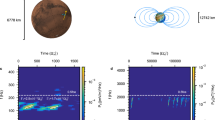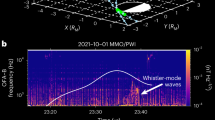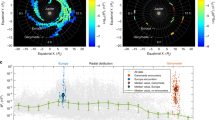Abstract
Using the data of LFEW/TC-2, we studied the dawn side chorus around substorm onsets during a strong geomagnetic storm in November 2004. During this storm, LFEW/TC-2 observed 14 dawnside chorus events. Nine of them were associated with substorms and occurred within 40 min around the substorm onsets. The frequencies of waves have a very good correlation with the half equatorial electron cyclotron frequencies. Chorus can be excited in the region near magnetic equatorial plane and then propagate to the mid and high latitudes. When the wave frequencies reach the local lower hybrid frequencies, chorus can be reflected due to the lower hybrid resonance. The time delay between the chorus and its echo is about 28 min. Previous observations show that the chorus can propagate at most to the magnetic latitudes of 40°. LFEW/ TC-2 found for the first time that the chorus in space could propagate to the magnetic latitude of 70°. Since most of the previous chorus observations are made close to the magnetic equatorial plane, our results are important for the studies of excitation and propagation of whistler mode wave, and relevant relativistic electron acceleration in the magnetosphere.
Similar content being viewed by others
References
Omura Y, Nunn D, Matsumoto H, et al. A review of observational, theoretical and numerical studies of VLF triggered emissions. J Atmos Terr Phys, 1991, 53: 351–368
Sazhin S, Hayakawa M. Magnetospheric chorus emissions:A review, Planet. Space Sci, 1992, 40: 681–697
Meredith N P, Cain M, Horne R B, et al. Evidence for chorus-driven electron acceleration to relativistic energies from a survey of geomagnetically disturbed periods. J Geophys Res, 2003, 108(A6): 1248–1256
Temerin M, Roth L, Hudson M K, et al. New paradigm for the transport and energization of radiation belt particles. Eos Trans AGU, 1994, 75: 538–548
Li X, Baker D N, Temerin M, et al. Are energetic electrons in the solar wind the source of the outer radiation belt? Geophys Res Lett, 1997, 24: 923–928
Horne R B, Glauert S A, Thorne R M. Resonant diffusion of radiation belt electrons by whistler-mode chorus. Geophys Res Lett, 2003, 30(9): 1493–1498
Horne R B and Thorne R M Relativistic electron acceleration and precipitation during resonant interactions with whistler-mode chorus. Geophys Res Lett, 2003, 30(10): 1527–1532
Li L, Cao J B, Zhou G C. Acceleration of seed electrons by whistler turbulences near the geosynchronous orbit. Chin J Geophys, 2004, 47: 857–862
Li L, Cao J B, Zhou G. C. Combined acceleration of electrons by whistler-mode and compressional ULF turbulences near the geosynchronous orbit. J Geophys Res, 2005, 110: A03203
Li L, Cao J B, Zhou G. C. Whistler-mode waves modify the high-energy electron slot region and the outer radiation belt. Chin J Geophys, 2008, 51(2): 361–324
Cao J B, Yang J, Yan C, et al. The observations of high energy electrons and associated waves by DSP satellites during substorm. Nuclear Phys B, 2007, 166(suppl): 56–61
Xiao F, He H, Zhou Q, et al. Relativistic diffusion coefficients for superluminous (auroral kilometric radiation) wave modes in space plasmas. J Geophys Res, 2006, 111: 11201–11210
Xiao F, Zhou Q, Zheng H, et al. Whistler instability threshold condition of energetic electrons by kappa distribution in space plasmas. J Geophys Res, 2006, 111: A08208
Xiao F, Thorne R M, Summers D, et al. Higher-order gyroresonant acceleration of electrons by superluminous (AKR) wave-modes. Planet Space Sci, 2007, 55: 1257
Zong Q G, Zhou X, Li X, et al. Ultralow frequency modulation of energetic particles in the dayside magnetosphere. Geophys Res Lett, 2007, 34: L12105
Nunn D, Omura Y, Matsumoto H, et al. The numerical simulation of VLF chorus and discrete emissions observed on the Geotail satellite using a Vlasov code. J Geophys Res, 1997, 102: 27083–27097
Trakhtengerts V. A generation mechanism for chorus emission. Ann Geophys, 1999, 17: 95–100
Kennel C F, Petschek H E. Limit on stable trapped particle fluxes. J Geophys Res, 1966, 71: 1–28
Burton R K, Holzer R E. The origin and propagation of chorus in the outer magnetosphere. J Geophys Res, 1974, 79: 1014–1023
LeDocq M J, Gurnett D A, Hospodarsky G B. Chorus source locations from VLF Poynting flux measurements with the Polar spacecraft. Geophys Res Lett, 1998, 25: 4063–4066
Santolık O, Gurnett D A, Pickett J S, et al. Spatio-temporal structure of storm-time chorus. J Geophys Res, 2003, 108: 1278–1308
Parrot M, Santolık O, Cornilleau-Wehrlin N. Source location of chorus emissions observed by Cluster. Ann Geophys, 2003, 21: 473–482
Santolık O, Gurnett D A, Pickett J S, et al. A microscopic and nanoscopic view of storm-time chorus on 31 March 2001. Geophys Res Lett, 2004, 31(2): L02801
Santolık O, Gurnett D A, Pickett J S, et al. Central position of the source region of storm-time chorus. Planet Space Sci, 2005, 53: 299–305
Parrot M, Santolik O, Cornilleau-Wehrlin N, et al. Magnetospherically reflected chorus waves revealed by ray tracing with Cluster data. Ann Geophys, 2003, 21: 1111
Santolık O, Macusova E, Yearby K H, et al. Radial variation of whistler-mode chorus: first results from the STAFF/DWP instrument on board the Double Star TC-1 spacecraft. Ann Geophys, 2005, 23: 2937–2942
Helliwell R A. A theory of discrete emissions from the magnetosphere. J Geophys Res, 1967, 72: 4773–4832
Helliwell R A. Low-frequency waves in the magnetosphere. Rev Geophys, 1969, 7: 281–392
Santolık O, Gurnett D A. Transverse dimensions of chorus in the source region, Geophys Res Lett, 2003, 30: 1031–1040
Goldstein B E, Tsurutani B T. Wave normal directions of chorus near the equatorial source region. J Geophys Res, 1984, 89: 2789–2810
Parrot M, Santolık O, Gurnett D, et al. Characteristics of magnetospherically reflected chorus waves observed by CLUSTER. Ann Geophys, 2004, 22: 2597–2606
Burtis W J, Helliwell R A. Magnetospheric chorus: Occurrence patterens and normalized frequency. Planet Space Sci, 1976, 24: 1007–1024
Tsurutani B T, Smith E J. Postmidnight chorus: a substorm phenomenon. J Geophys Res, 1974, 79: 118–127
Smith A J, Freeman M, Reeves R. Postmidnight VLF chorus events, a substorm signature observed on the ground near L = 4. J Geophys Res, 1996, 101: 24641–24653
Smith A J, Freeman M, Reeves R. Correction to “Postmidnight VLF chorus events, a substorm signature observed on the ground near L = 4”. J Geophys Res, 1997, 102: 2433–2434
Smith A J, Freeman M, Wickett M, et al. On the relationship between the magnetic and VLF signatures of the substorm expansion phase. J Geophys Res, 1999, 104: 12351–12360
Abel G A, Smith A, Meredith N, et al. Temporal evolution of substorm-enhanced whistler-mode waves: Relationship between space-based observations, ground-based observations and energetic electrons. J Geophys Res, 2005, 109: A10207
Abel G A, Freeman M, Smith A, et al. Association of substorm chorus events with drift echoes. J Geophys Res, 2006, 111: A11220
Hwang J A, Lee D Y, Lyons L R, et al. Statistical significance of association between whistler-mode chorus enhancements and enhanced convection periods during highspeed streams. J Geophys Res, 2007, 11: 09213–09224
Lyons L R, Lee D Y, Thorne M, et al. Solar wind-magnetosphere coupling leading to relativistic electron energization during high-speed streams. J Geophys Res, 2005, 110: A11202, doi:10.1029/2005JA011254
Liu Z X, Escoubet P, Cao J B. A Chinese European Multiscale mission: the double star program, In: Lui A T Y, Kamide Y, Consolini G, eds. Multiscale Coupling of Sun-Earth Processes. Dordrecht: Elsevier, 2005. 509–514
Cao J B, Liu Z X, Yan C X, et al. First results of Chinese Particle Instruments on DSP. Ann Geophys, 2005, 23: 2775–2784
Cao J B, Liu Z X, Yang J Y, et al. First results of Low Frequency Electromagnetic Wave Detector. Ann Geophys, 2005, 23: 2803–2811
OBrien T P, Moldwin M. Empirical plasmapause models from magnetic indices. Geophys Res Lett, 2003, 30: 1152–1160
Yang J, Cao J B, Yan C X, et al. The acceleration of energetic electrons associated with chorus observed by TC-2. Nuclear Phys B, 2007, 166(suppl): 276–278
Author information
Authors and Affiliations
Corresponding author
Additional information
Supported by the National Natural Science Foundation of China (Grant Nos. 40621003, 40523006, 40704028, 40604018), 973 Program of China (Grant No. 2006CB806305), and the Specialized Research Fund for State Key Laboratories of China.
Rights and permissions
About this article
Cite this article
Yang, J., Cao, J., Yan, C. et al. The mid-high latitude whistler mode chorus waves observed around substorm onsets. Sci. China Ser. E-Technol. Sci. 51, 1648–1658 (2008). https://doi.org/10.1007/s11431-008-0257-8
Received:
Accepted:
Published:
Issue Date:
DOI: https://doi.org/10.1007/s11431-008-0257-8




